Spatio-Temporal Patterns and Trade-Offs/Synergies of Land Use Functions at the Township Scale in Special Ecological Functional Zones
Abstract
1. Introduction
2. Materials and Methods
2.1. Study Area
2.2. Data Sources and Processing
2.3. Methods
2.3.1. Research Framework
2.3.2. LUFs Assessment
| Target Layer | Guidelines Layer (Weight) | Metrics Layer | Calculation | Formula Description |
|---|---|---|---|---|
| PF | Grain production (0.1455) | Grain yield | represent the sown area (km2) of grain crops in grid cell i and county j, respectively. The grain crop types include wheat, maize, and pulses. | |
| Supply of forest products (0.2438) | Garden fruit yield | represent the forest land area (km2) in grid cell i and county j, respectively. In this study, the yield of forest products is represented by orchard fruits. | ||
| Supply of Livestock products (0.2490) | Meat production | represent the land area (km2) allocated for livestock rearing in grid cell i and county j, respectively. In this study, the yield of livestock products is represented by the meat yield (including cattle, sheep, and swine), and the rearing land area is substituted with grassland area. | ||
| Non-agricultural production (0.3617) | Secondary and tertiary output value | denote the nighttime light (NTL) data values in grid cell i and county j, respectively. | ||
| LF | Residential Carrying capacity (0.3411) | Urban and rural construction land density | represent the urban–rural construction land area and grid cell area in grid cell i, respectively. | |
| Life maintenance (0.3241) | Population density | represent the composite weighting (integrating land use type, nighttime light data, and residential density) for grid cell i and county j, respectively. | ||
| Traffic guarantee (0.3349) | Road density | denotes the area (km2) of grid cell i. The weights for railway, expressway, national highway, provincial highway, and county highway are set to 0.35, 0.25, 0.20, 0.15, and 0.05, respectively. | ||
| EF | Climate regulation (0.1393) | Carbon sequestration | InVEST [47] | |
| Water conservation (0.2122) | Annual water production | InVEST [48] | ||
| Soil conservation (0.4382) | Soil retention | InVEST [49] | ||
| Habitat maintenance (0.2103) | Habitat quality | InVEST [50] |
2.3.3. Global Spatial Autocorrelation
2.3.4. Spearman Correlation Coefficient
2.3.5. GWR and Bivariate Local Spatial Autocorrelation
3. Results
3.1. Spatio-Temporal Evolution Characteristics of LUFs
3.1.1. Overall Characteristics and Temporal Changes
3.1.2. Spatial Pattern and Evolution Characteristics of PF
3.1.3. Spatial Pattern and Evolution Characteristics of LF
3.1.4. Spatial Pattern and Evolution Characteristics of EF
3.2. Overall TOSs Among LUFs
3.3. Spatial Non-Stationarity Characteristics of TOSs Between Different Function Changes
3.3.1. Spatial Non-Stationarity and Type Spatial Pattern of TOSs Between PF and LF
3.3.2. Spatial Non-Stationarity and Type Spatial Pattern of TOSs Between PF and EF
3.3.3. Spatial Non-Stationarity and Type Spatial Pattern of TOSs Between LF and EF
4. Discussion
4.1. Potential Mechanisms of Spatial Distribution and Dynamic Evolution of LUFs
4.2. Potential Mechanisms of TOS and Spatial Non-Stationarity Between LUF Changes
4.3. Policy Recommendations Based on Interactive Relationships of Different LUFs
- (1)
- Areas of TOS types between PF-LF. In linear synergy areas (e.g., townships in counties such as Yichuan County in the northeast of the Funiu Mountain area), relying on the advantages of plains and suburban locations, we should optimize the spatial coupling layout of industrial parks and new communities, improve facilities such as cold chain logistics and vocational education, strengthen the driving role of PF on LF, and consolidate the stability of synergy. In concave trade-off areas (e.g., townships in counties such as Lushan County in the east of the Funiu Mountain area), aiming at the phased breakthrough of functions, it is necessary to strictly demarcate the red line for returning sloping farmland to forests, promote ecological agriculture such as chestnuts and Chinese medicinal materials, and improve the density of rural road networks to enhance the connectivity of production-living spaces, promoting the transition from trade-off to synergy.
- (2)
- Areas of TOS types between PF-EF. In convex trade-off areas (e.g., townships in counties such as Lushi County in the northwest of the Funiu Mountain area), addressing the strong negative correlation between production expansion and ecological degradation, strictly adhere to ecological thresholds, implement mine restoration and ecological migration, establish a mechanism for ecological feedback from mineral proceeds, and curb the vicious cycle. In concave trade-off areas (e.g., townships in counties such as Xixia County), focusing on the trend of conflict mitigation, we could deepen the intensive development of characteristic agriculture and ecotourism, establish a mechanism for premium sharing of ecological products, and reduce the rate of ecological loss.
- (3)
- Areas of TOS types between LF-EF. In linear synergy areas (e.g., townships in counties such as Luanchuan County), addressing the synergetic characteristics of LF and EF, we need to strengthen the management and control of core ecological areas, expand the integrated model of under-forest economy and carbon sink trading, establish a mechanism linking ecological compensation with biodiversity, and consolidate the win-win pattern.
- (4)
- Construct a multi-dimensional coordination system to promote the sustainable development of regional LUFs. To establish a dynamic monitoring platform for LUFs in the Funiu Mountain area to track the evolution trend of functional interactions in real time; in the context of urban development shifting from incremental expansion to stock optimization, effectively reduce the impact of urban expansion on land, especially cultivated land; provide incentive indicators for synergy areas and implement restrictive indicator management for trade-off areas, and optimize the regional land use structure through differentiated territorial space planning indicator allocation; and promote the spatial connection between ecological protection red lines and rural revitalization plans to realize the sustainable development of ecological protection and regional economy.
4.4. Limitations and Prospects
5. Conclusions
Author Contributions
Funding
Data Availability Statement
Conflicts of Interest
References
- Meng, J.; Cheng, H.; Li, F.; Han, Z.; Wei, C.; Wu, Y.; You, N.; Zhu, L. Spatial-temporal trade-offs of land multi-functionality and function zoning at finer township scale in the middle reaches of the Heihe River. Land Use Policy 2022, 115, 106019. [Google Scholar] [CrossRef]
- Peng, R.; Liu, T.; Cao, G. Valuating Multifunctionality of Land Use for Sustainable Development: Framework, Method, and Application. Land 2023, 12, 222. [Google Scholar] [CrossRef]
- Paracchini, M.; Pacini, C.; Jones, M.; Pérez-Soba, M. An aggregation framework to link indicators associated with multifunctional land use to the stakeholder evaluation of policy options. Ecol. Indic. 2011, 11, 71–80. [Google Scholar] [CrossRef]
- Schößer, B.; Helming, K.; Wiggering, H. Assessing land use change impacts—A comparison of the sensor land use function approach with other frameworks. J. Land Use Sci. 2010, 5, 159–178. [Google Scholar] [CrossRef]
- Liu, C.; Cheng, L.; Li, J.; Lu, X.; Xu, Y.; Yang, Q. Trade-offs analysis of land use functions in a hilly-mountainous city of northwest Hubei Province: The interactive effects of urbanization and ecological construction. Habitat Int. 2023, 131, 102705. [Google Scholar] [CrossRef]
- Fan, Y.; Jin, X.; Gan, L.; Jessup, H.; Pijanowski, C.; Yang, X.; Xiang, X.; Zhou, Y. Spatial identification and dynamic analysis of land use functions reveals distinct zones of multiple functions in eastern China. Sci. Total Environ. 2018, 642, 33–44. [Google Scholar] [CrossRef]
- Zou, L.; Liu, Y.; Wang, J.; Yang, Y. An analysis of land use conflict potentials based on ecological-production-living function in the southeast coastal area of China. Ecol. Indic. 2021, 122, 107297. [Google Scholar] [CrossRef]
- Pérez-Soba, M.; Petit, S.; Jones, L.; Bertrand, N.; Briquel, V.; Omodei-Zorini, L.; Contini, C.; Helming, K.; Farrington, J.; Mossello, M.; et al. Land use functions: A multifunctionality approach to assess the impact of land use changes on land use sustainability. In Sustainability Impact Assessment of Land Use Changes; Helming, K., Pérez-Soba, M., Tabbush, P., Eds.; Springer: Berlin/Heidelberg, Germany, 2008; pp. 375–404. [Google Scholar]
- Organization for Economic Cooperation and Development (OECD). Multifunctionality: Towards an Analytical Framework; Organization for Economic Cooperation and Development: Paris, France, 2001. [Google Scholar]
- Millennium Ecosystem Assessment (MEA). Ecosystems and Human Well-Being; Island Press: Washington, DC, USA, 2005. [Google Scholar]
- Costanza, R. Valuing natural capital and ecosystem services toward the goals of efficiency, fairness, and sustainability. Ecosyst. Serv. 2020, 43, 101096. [Google Scholar] [CrossRef]
- Willemen, L.; Verburg, P.; Hein, L.; Mensvoort, M. Spatial characterization of landscape functions. Landsc. Urban Plan. 2008, 88, 34–43. [Google Scholar] [CrossRef]
- Peng, J.; Lv, H.; Liu, Y.; Chen, X.; Hu, X. International research progress and perspectives on multi-functional landscape. Adv. Earth Sci. 2015, 30, 465–476. [Google Scholar]
- Kienast, F.; Bolliger, J.; Potschin, M.; Groot, R.; Vervurg, P.; Heller, I.; Wascher, D.; Haines-Young, R. Assessing land-scape functions with broad-scale environmental data: Insights gained from a prototype development for Europe. Environ. Manag. 2009, 44, 1099–1120. [Google Scholar] [CrossRef]
- Sun, P.; Xu, Y.; Liu, Q.; Liu, C.; Huang, A. Spatiotemporal differentiation and driving factors of multi-functionality of land use in county scale in poverty belt around Beijing and Tianjin. Trans. Chin. Soc. Agric. Eng. 2017, 33, 283–292. [Google Scholar]
- Liu, C.; Xu, Y.; Sun, P.; Liu, J. Progress and prospects of multi-functionality of land use research. Prog. Geogr. 2016, 35, 1087–1099. [Google Scholar]
- Cao, S.; Li, F.; Wei, Y.; Xie, G.; Yang, L.; Zhen, L. Land Use Functions: Conceptual Framework and Application for China. Resour. Sci. 2009, 31, 544–551. [Google Scholar]
- Chen, J.; Shi, P. Discussion on functional and use classification system. J. Beijing Norm. Univ. Nat. Sci. 2005, 41, 536–540. [Google Scholar]
- Zhang, X.; Zhu, D.; Xu, Z. Assessment on multi-functionality of land use in Tibet. Trans. Chin. Soc. Agric. Eng. 2014, 30, 185–194. [Google Scholar]
- Lyu, Y.; Wang, M.; Zou, Y.; Wu, C. Mapping trade-offs among urban fringe land use functions to accurately support spatial planning. Sci. Total Environ. 2022, 802, 149915. [Google Scholar] [CrossRef]
- Ren, J.; Ma, R.; Huang, Y.; Wang, Q.; Guo, J.; Li, C.; Zhou, W. Identifying the trade-offs and synergies of land use functions and their influencing factors of Lanzhou-Xining urban agglomeration in the upper reaches of Yellow River Basin, China. Ecol. Indic. 2024, 158, 11279. [Google Scholar] [CrossRef]
- Zhang, J.; Li, S.; Lin, N.; Lin, Y.; Yuan, S.; Zhang, L.; Zhu, J.; Wang, K.; Gan, M.; Zhu, C. Spatial identification and trade-off analysis of land use functions improve spatial zoning management in rapid urbanized areas, China. Land Use Policy 2022, 116, 106058. [Google Scholar] [CrossRef]
- Li, S.; An, W.; Zhang, J.; Gan, M.; Wang, K.; Ding, L.; Li, W. Optimizing limit lines in urban-rural transitional areas: Unveiling the spatial dynamics of trade-offs and synergies among land use functions. Habitat Int. 2023, 140, 102907. [Google Scholar] [CrossRef]
- Zhu, C.; Dong, B.; Li, S.; Lin, Y.; Shahtahmassebi, A.; You, S.; Zhang, J.; Gan, M.; Yang, L.; Wang, K. Identifying the trade-offs and synergies among land use functions and their influencing factors from a geospatial perspective: A case study in Hangzhou China. J. Clean. Prod. 2021, 314, 128026. [Google Scholar] [CrossRef]
- Wei, C.; Wu, Z.; Xing, J.; Jin, G. Trade-off or synergy? Dynamic analysis and policy insights on land use functions in China. Environ. Impact Assess. Rev. 2024, 105, 107399. [Google Scholar] [CrossRef]
- Zhou, K.; Sun, Z.; Ma, T.; Li, Y.; Xie, B. Spatiotemporal Heterogeneity and Zoning Strategies of Multifunctional Trade-Offs and Synergies in Cultivated Land in the Hexi Corridor. Land 2025, 14, 335. [Google Scholar] [CrossRef]
- Li, K.; Zhao, J.; Li, Y.; Lin, Y. Identifying trade-offs and synergies among land use functions using an XGBoost-SHAP model: A case study of Kunming, China. Ecol. Indic. 2025, 172, 113330. [Google Scholar] [CrossRef]
- Li, X.; Lu, Z. Exploring the Balance Between Ecosystem Services and Economic Benefits via Multi-Objective Land Use Optimization. Land 2025, 14, 920. [Google Scholar] [CrossRef]
- Verburg, P.; Steeg, J.; Veldkamp, A.; Willemen, L. From land cover change to land function dynamics: A major challenge to improve land characterization. J. Environ. Manag. 2009, 90, 1327–1335. [Google Scholar] [CrossRef]
- Kim, I.; Arnhold, S. Mapping environmental land use conflict potentials and ecosystem services in agricultural watersheds. Sci. Total Environ. 2018, 630, 827–838. [Google Scholar] [CrossRef]
- Chen, Z.; Li, Y.; Liu, Y.; Liu, X. Does rural residential land expansion pattern lead to different impacts on eco-environment? A case study of loess hilly and gully region China. Habitat Int. 2021, 117, 102436. [Google Scholar] [CrossRef]
- Bradford, J.; D’Amato, A. Recognizing trade-offs in multi-objective land management. Front. Ecol. Environ. 2012, 10, 210–216. [Google Scholar] [CrossRef]
- Turkelboom, F.; Leone, M.; Jacobs, S.; Kelemen, E.; García-Llorente, M.; Baró, F.; Termansen, M.; Barton, D.; Berry, P.; Stange, E.; et al. When we cannot have it all: Ecosystem services trade-offs in the context of spatial planning. Ecosyst. Serv. 2018, 29, 566–578. [Google Scholar] [CrossRef]
- Cheng, L.; Cui, H.; Liang, T.; Huang, D.; Su, Y.; Zhang, Z.; Wen, C. Study on the Trade-Off Synergy Relationship of “Production-Living-Ecological” Functions in Chinese Counties: A Case Study of Chongqing Municipality. Land 2023, 12, 1010. [Google Scholar] [CrossRef]
- Li, X.; Lu, Z. Spatiotemporal Evolution of Land Use Structure and Function in Rapid Urbanization: The Case of the Beijing–Tianjin–Hebei Region. Land 2024, 13, 1651. [Google Scholar] [CrossRef]
- Tran, D.; Pearson, D.; Palmer, A.; Lowry, J.; Gray, D.; Dominati, E. Quantifying spatial non-stationarity in the relationship between landscape structure and the provision of ecosystem services: An example in the New Zealand hill country. Sci. Total Environ. 2022, 808, 152126. [Google Scholar] [CrossRef] [PubMed]
- Fan, Y.; Gan, L.; Hong, C.; Jessup, L.; Jin, X.; Pijanowski, B.; Lyu, L. Spatial identification and determinants of trade-offs among multiple land use functions in Jiangsu Province, China. Sci. Total Environ. 2021, 772, 145022. [Google Scholar] [CrossRef] [PubMed]
- Deng, W.; Zhang, S.; Zhang, H.; Peng, L.; Liu, Y. Transitional geospace from the perspective of human-nature coupling: Concept, connotations, attributes, and the research framework. Geogr. Res. 2020, 39, 761–771. [Google Scholar]
- Yang, Y.; Ren, X.; Yan, J. Trade-offs or synergies? Identifying dynamic land use functions and their interrelations at the grid scale in urban agglomeration. Cities 2023, 140, 104384. [Google Scholar] [CrossRef]
- Zou, L.; Liu, Y.; Yang, J.; Yang, S.; Wang, Y.; Cao, Z.; Hu, X. Quantitative identification and spatial analysis of land use ecological-production-living functions in rural areas on China’s southeast coast. Habitat Int. 2020, 100, 102182. [Google Scholar] [CrossRef]
- Long, H.; Li, M.; Zhang, Y.; Qu, L. Multifunctional rural development in China: Pattern, process and mechanism. Habitat Int. 2022, 121, 102530. [Google Scholar] [CrossRef]
- Li, J.; Sun, R.; Xiong, M.; Yang, G. Estimation of soil erosion based on the RUSLE model in China. Acta Ecol. Sin. 2020, 40, 3473–3485. [Google Scholar] [CrossRef]
- Liu, Q.; Qiao, J.; Li, M.; Huang, M. Spatiotemporal heterogeneity of ecosystem service interactions and their drivers at different spatial scales in the Yellow River basin. Sci. Total Environ. 2024, 908, 168486. [Google Scholar] [CrossRef]
- Liu, Y.; Liu, X.; Zhao, C.; Wang, H.; Zang, F. The trade-offs and synergies of the ecological-production-living functions of grassland in the Qilian mountains by ecological priority. J. Environ. Manag. 2023, 327, 116883. [Google Scholar] [CrossRef]
- Fan, Y.; Jin, X.; Gan, L.; Jessup, L.; Pijanowski, B.; Lin, J.; Yang, Q.; Lyu, L. Dynamics of spatial associations among multiple land use functions and their driving mechanisms: A case study of the Yangtze River Delta region, China. Environ. Impact Assess. Rev. 2022, 97, 106858. [Google Scholar] [CrossRef]
- Wang, M.; Jiang, Z.; Li, T.; Yang, Y.; Jia, Z. Analysis on absolute conflict and relative conflict of land use in Xining metropolitan area under different scenarios in 2030 by PLUS and PFCI. Cities 2023, 137, 104314. [Google Scholar] [CrossRef]
- Peng, J.; Tian, L.; Liu, Y.; Zhao, M.; Hu, Y.; Wu, J. Ecosystem services response to urbanization in metropolitan areas: Thresholds identification. Sci. Total Environ. 2017, 607–608, 706–714. [Google Scholar] [CrossRef]
- Pei, S.; Zhang, C.; Liu, C.; Liu, X.; Xie, G. Forest ecological compensation standard based on spatial flowing of water services in the upper reaches of Miyun Reservoir, China. Ecosyst. Serv. 2019, 39, 100983. [Google Scholar] [CrossRef]
- Ouyang, Z.; Zheng, H.; Xiao, Y.; Polasky, S.; Xu, W.; Wang, Q.; Zhang, L.; Xiao, Y.; Ran, E.; Jiang, L.; et al. Improvements in ecosystem services from investments in natural capital. Science 2016, 352, 1455–1459. [Google Scholar] [CrossRef] [PubMed]
- Zhao, X.; Li, J.; Ruan, F.; Zou, Z.; He, X.; Zhou, C. Spatiotemporal Dynamics and Multi-Scenario Projections of the Land Use and Habitat Quality in the Yellow River Basin: A GeoDetector-PLUS-InVEST Integrated Framework for a Coupled Human-Natural System Analysis. Remote Sens. 2025, 17, 2181. [Google Scholar] [CrossRef]
- Cliff, A.; Ord, J. Spatial Processes, Models and Applications; Pion: London, UK, 1981. [Google Scholar]
- Lin, S.; Wu, R.; Yang, F.; Wang, J.; Wu, W. Spatial trade-offs and synergies among ecosystem services within a global biodiversity hotspot. Ecol. Indic. 2018, 84, 371–381. [Google Scholar] [CrossRef]
- Brunsdon, C.; Fotheringham, S.; Charlton, M. Geographically weighted regression. J. R. Stat. Soc. Ser. D Stat. 1998, 47, 431–443. [Google Scholar] [CrossRef]
- He, X.; Zhou, Y.; Yuan, Y. Exploring the relationship between urban polycentricity and consumer amenity development: An empirical study using Dianping Data in China. Cities 2025, 166, 106197. [Google Scholar] [CrossRef]
- Li, S.; Zhu, C.; Lin, Y.; Dong, B.; Chen, B.; Si, B.; Li, Y.; Deng, X.; Gan, M.; Zhang, J.; et al. Conflicts between agricultural and ecological functions and their driving mechanisms in agroforestry ecotone areas from the perspective of land use functions. J. Clean. Prod. 2021, 317, 128453. [Google Scholar] [CrossRef]
- He, X.; Zhang, R.; Yuan, X.; Cao, Y.; Zhou, C. The role of planning policy in the evolution of the spatial structure of the Guangzhou metropolitan area in China. Cities 2023, 137, 104284. [Google Scholar] [CrossRef]
- Anselin, L.; Syabri, I.; Smirnov, O. Visualizing Multivariate Spatial Correlation with Dynamically Linked Windows; University of California Santa Barbara Cd Rom: Santa Barbara, CA, USA, 2002. [Google Scholar]
- Guo, C.; Gao, S.; Zhou, B.; Gao, J. Effects of land use change on ecosystem service value in Funiu Mountain based upon a grid square. Acta Ecol. Sin. 2019, 39, 3482–3493. [Google Scholar] [CrossRef]
- Li, L.; Zhou, X.; Yang, L.; Duan, J.; Zeng, Z. Spatio-Temporal Characteristics and Influencing Factors of Ecological Risk in China’s North–South Transition Zone. Sustainability 2022, 14, 5464. [Google Scholar] [CrossRef]
- Körner, C. The use of ‘altitude’ in ecological research. Trends Ecol. Evol. 2007, 22, 569–574. [Google Scholar] [CrossRef] [PubMed]
- Berry, B.; Baskin, C.; Christaller, W. Central Places in Southern Germany. Econ. Geogr. 1967, 43, 275. [Google Scholar] [CrossRef]
- Liu, X.; Huang, M.; Lei, W. Spatiotemporal evolution of land use in ecologically fragile areas of the loess plateau in northern Shaanxi. Chin. J. Agric. Resour. Reg. Plan. 2023, 44, 47–57. [Google Scholar]
- Li, S.; Yang, R.; Long, H.; Lin, Y.; Ge, Y. Rural spatial restructuring in suburbs under capital intervention: Spatial construction based on nature. Habitat Int. 2024, 150, 103112. [Google Scholar] [CrossRef]
- Qiao, W.; Li, C.; Dai, L.; Jia, K.; Yang, C. Progress and prospects in the study of coupling rural multifunctional evolution and land use transitions. Geogr. Res. 2024, 43, 1556–1571. [Google Scholar]
- Zhang, H.; Tang, Q.; He, X.; Yang, Q. Land use function changes and trade-offs/synergies across topographic gradients in the Three Gorges Reservoir Area, China. J. Clean. Prod. 2024, 469, 143233. [Google Scholar] [CrossRef]
- Goodchild, F. How well do we really know the world? Uncertainty in GIScience. J. Spat. Inf. Sci. 2020, 20, 97–102. [Google Scholar] [CrossRef]
- Zhong, C.; Chen, J.; Yi, B.; Li, H. Examining the reliable trend of global urban land use efficiency from 1985 to 2020 using robust indicators and analysis tools. Habitat Int. 2025, 163, 103477. [Google Scholar] [CrossRef]
- Liu, Y.; Wang, K.; Xing, X.; Guo, H.; Zhang, W.; Luo, Q.; Gao, S.; Huang, Z.; Li, H.; Li, X.; et al. On spatial effects in geographical analysis. Acta Geogr. Sin. 2023, 78, 517–531. [Google Scholar]
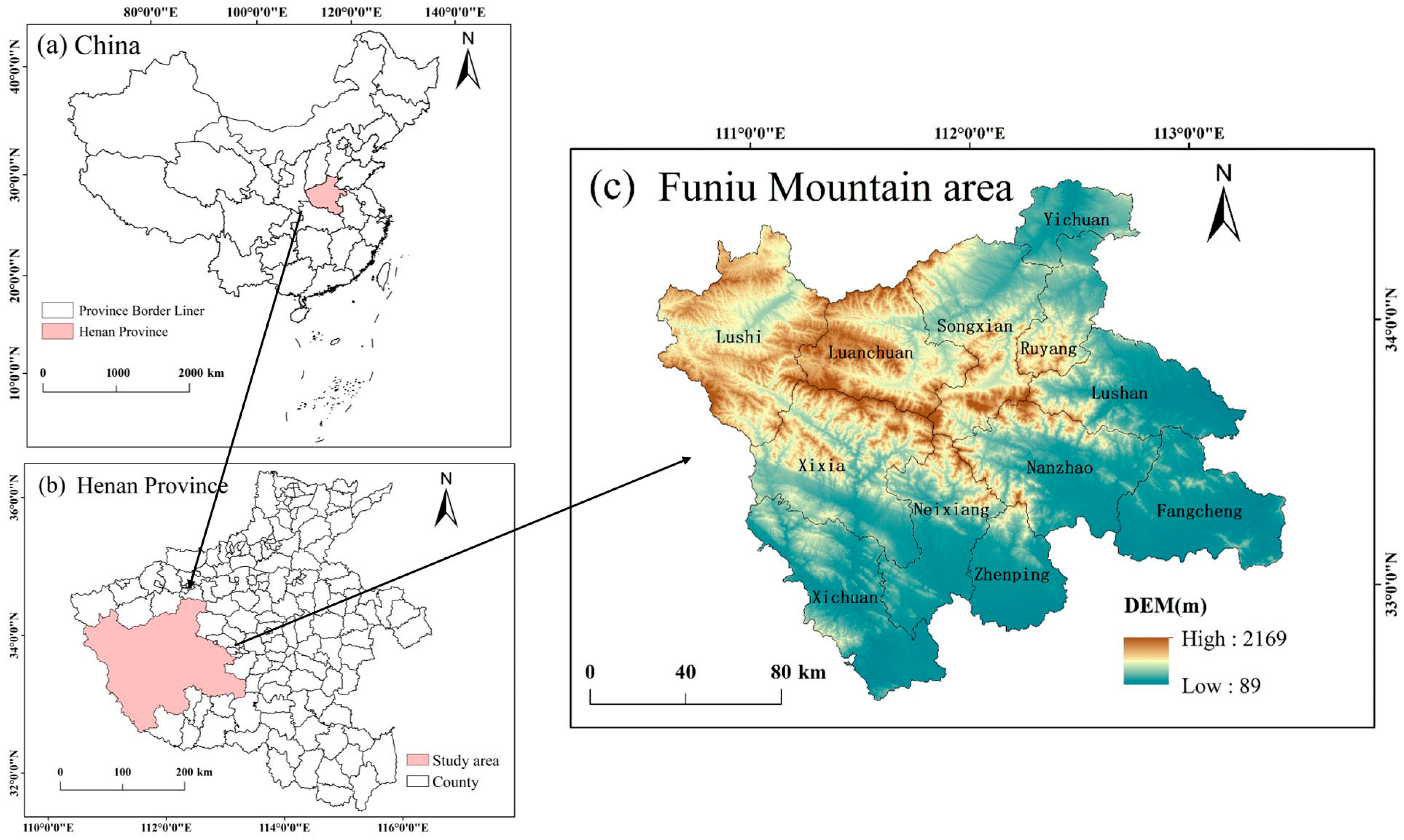


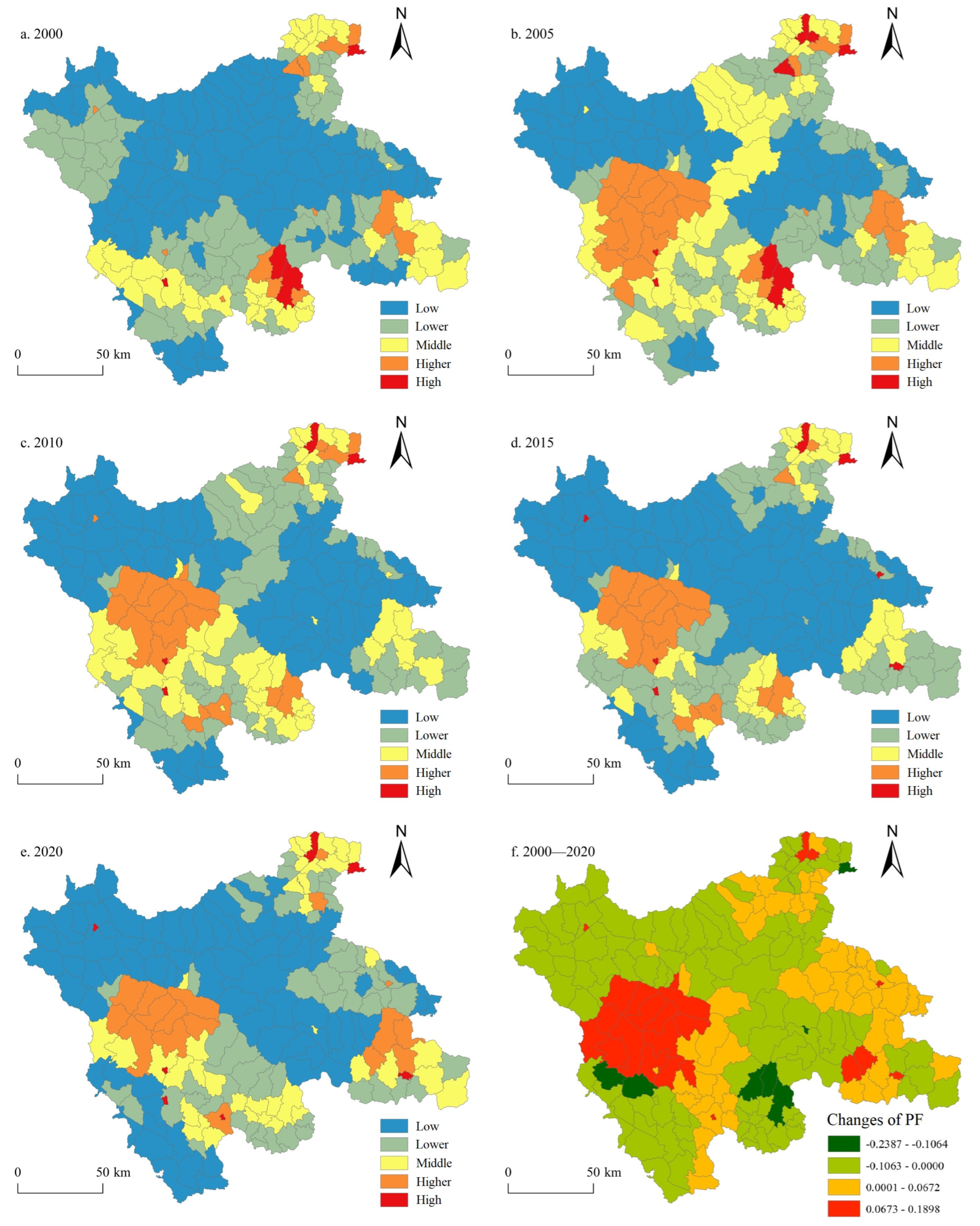

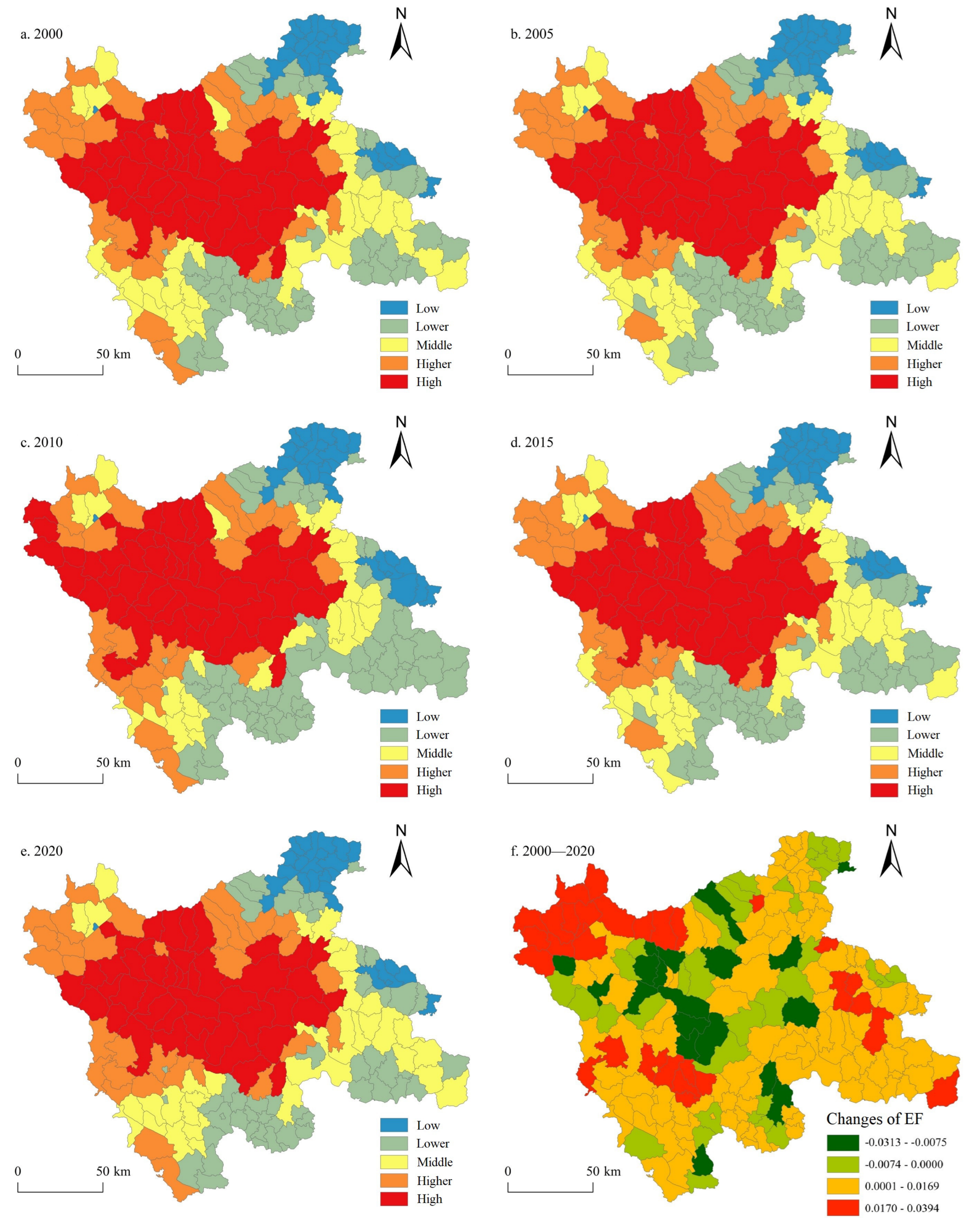
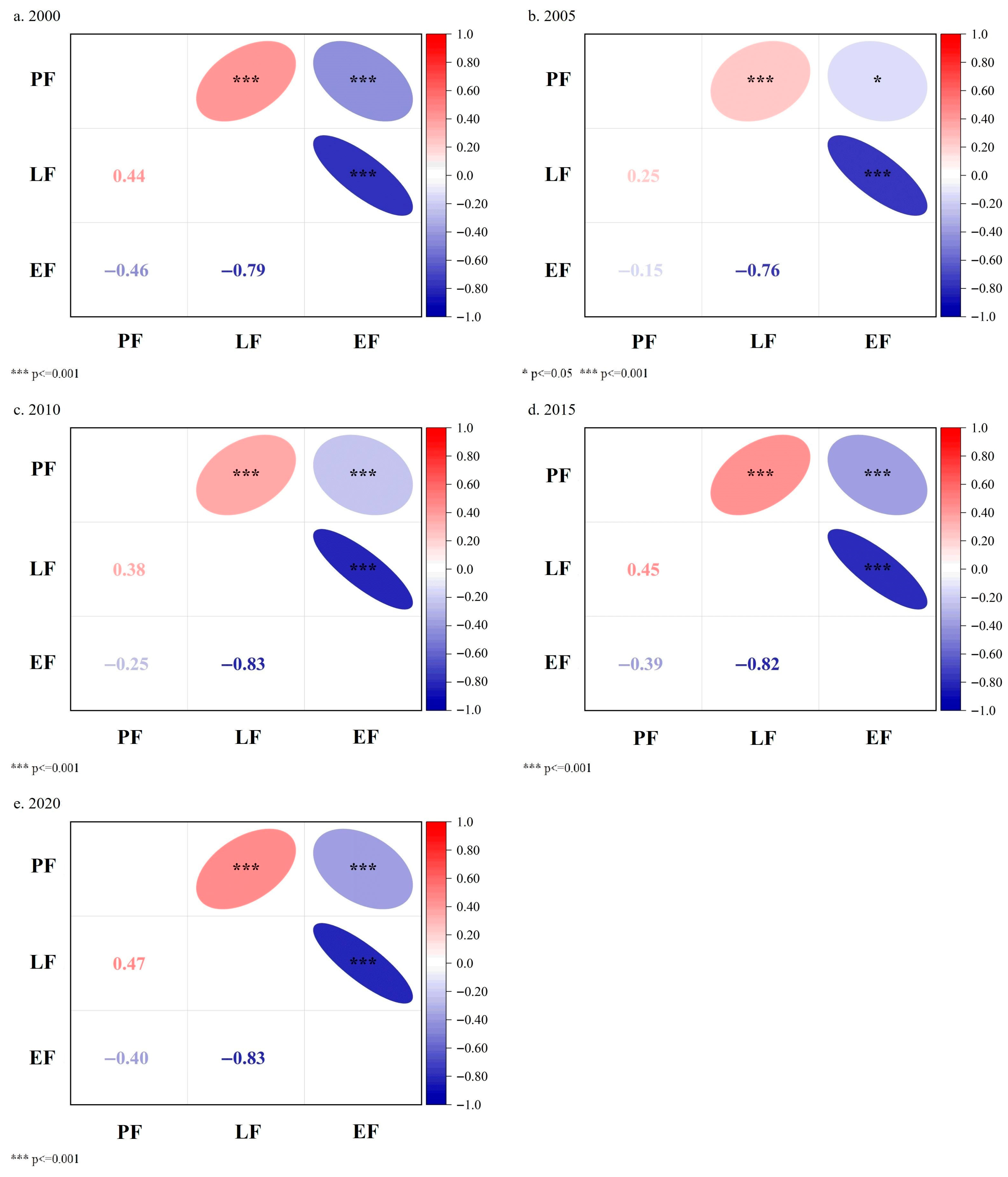
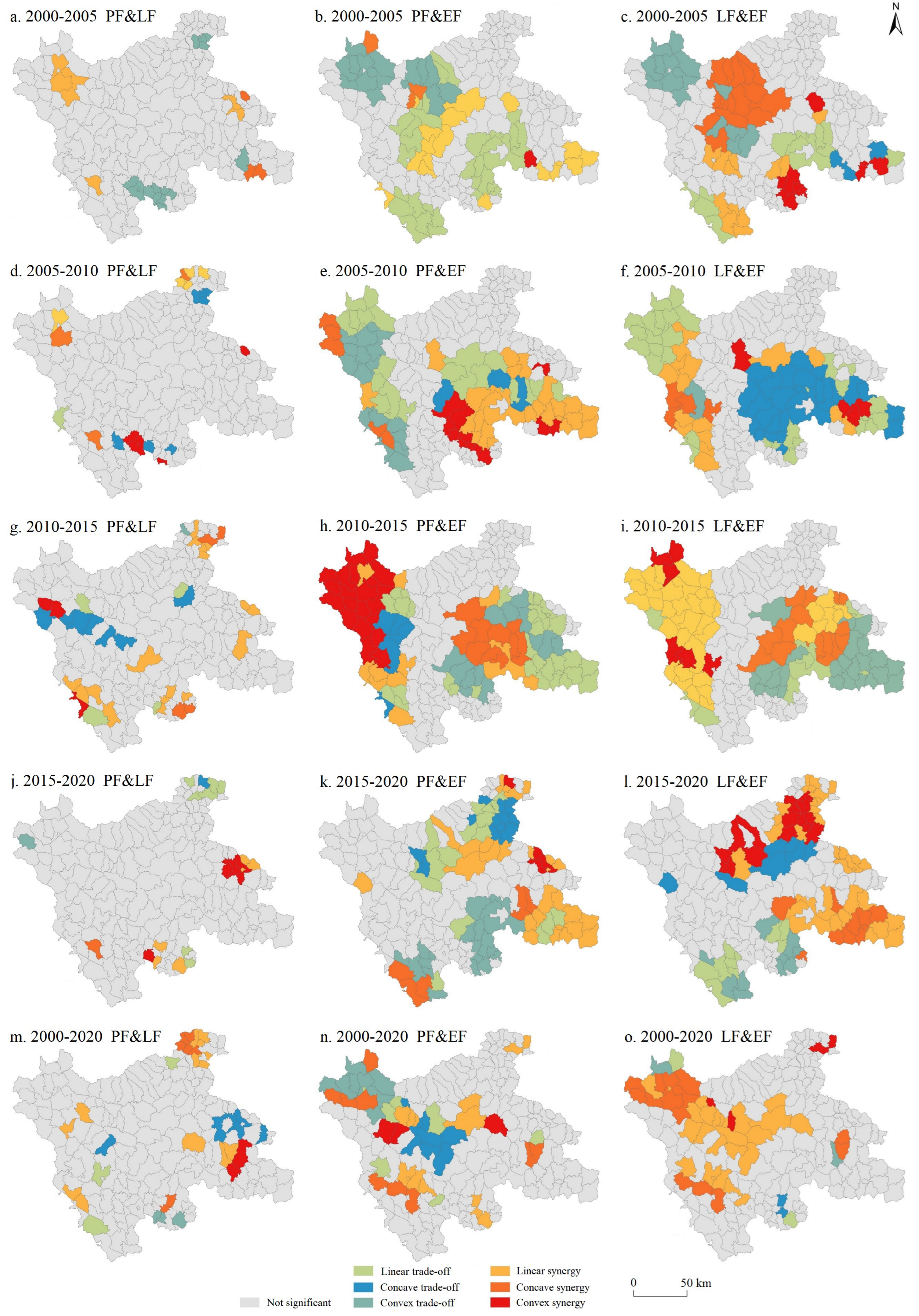
| Data | Source | Note |
|---|---|---|
| Land use data | The 30 m annual land cover datasets and their dynamics in China from 1990 to 2021 [Data set] (https://zenodo.org/records/5816591) (accessed on 3 September 2025) | Raster; 30 m × 30 m |
| Digital elevation model (DEM) | Geographic Spatial Data Cloud (http://www.gscloud.cn) (accessed on 3 September 2025) | Raster; 30 m × 30 m |
| Soil data | World Soil Information (https://data.isric.org) (accessed on 3 September 2025) | Raster; 1 km × 1 km |
| Precipitation | China Meteorological Data Website (https://data.cma.cn/site) (accessed on 3 September 2025) | Station |
| Evapotranspiration, Temperature | National Tibetan Plateau/Third Pole Environment Data Center (https://data.tpdc.ac.cn) (accessed on 3 September 2025) | Raster; 1 km × 1 km |
| Road data | Data Center for Resources and Environmental Sciences, Chinese Academy of Sciences (RESDC) (https://www.resdc.cn) (accessed on 3 September 2025) | Vector (line) |
| Night light data | National Earth System Science Data Sharing Platform in China (https://www.geodata.cn/) (accessed on 3 September 2025) | Raster; 500 m × 500 m |
| Population | WorldPop Global Project Population Data (https://www.worldpop.org/) (accessed on 3 September 2025) | Raster; 100 m × 100 m |
| Socioeconomic statistics data | Henan Statistical Yearbook (https://tjj.henan.gov.cn/) (accessed on 3 September 2025) | Statistics |
| Interrelationship | Type | Spatial Representation | Specific Meaning | |
|---|---|---|---|---|
| Synergy | Positive linear | High-high agglomeration or low-low agglomeration | An increase (decrease) in one function will cause another function to increase (decrease) proportionally. | |
| Nonlinear | Convex synergy | High-low agglomeration | Both functions increase simultaneously, but the growth of one function will slow down the growth of the other. | |
| Concave synergy | Low-high agglomeration | Both functions increase simultaneously, but the growth of one function will accelerate the growth of the other. | ||
| Trade-off | Negative linear | High-high agglomeration or low-low agglomeration | An increase (decrease) in one function will cause another function to decrease (increase) proportionally. | |
| Nonlinear | Convex trade-off | Low-high agglomeration | One function increases while another decreases, and the addition of one function will continuously accelerate the loss of the other. | |
| Concave trade-off | High-low agglomeration | One function increases while another decreases, and the increase in one function will continuously slow down the loss of the other. | ||
| Not significant | NO | Random | Adding or reducing one function has no impact on another function. | |
| 2000 | 2005 | 2010 | 2015 | 2020 | |
|---|---|---|---|---|---|
| PF | 0.4658 | 0.4185 | 0.4258 | 0.4220 | 0.4202 |
| LF | 0.3132 | 0.5412 | 0.3263 | 0.3943 | 0.3629 |
| EF | 0.8627 | 0.8695 | 0.8647 | 0.8655 | 0.8783 |
Disclaimer/Publisher’s Note: The statements, opinions and data contained in all publications are solely those of the individual author(s) and contributor(s) and not of MDPI and/or the editor(s). MDPI and/or the editor(s) disclaim responsibility for any injury to people or property resulting from any ideas, methods, instructions or products referred to in the content. |
© 2025 by the authors. Licensee MDPI, Basel, Switzerland. This article is an open access article distributed under the terms and conditions of the Creative Commons Attribution (CC BY) license (https://creativecommons.org/licenses/by/4.0/).
Share and Cite
Yang, J.; Zhang, J.; Li, C.; Gao, J. Spatio-Temporal Patterns and Trade-Offs/Synergies of Land Use Functions at the Township Scale in Special Ecological Functional Zones. Land 2025, 14, 1812. https://doi.org/10.3390/land14091812
Yang J, Zhang J, Li C, Gao J. Spatio-Temporal Patterns and Trade-Offs/Synergies of Land Use Functions at the Township Scale in Special Ecological Functional Zones. Land. 2025; 14(9):1812. https://doi.org/10.3390/land14091812
Chicago/Turabian StyleYang, Jie, Jiashuo Zhang, Chenyang Li, and Jianhua Gao. 2025. "Spatio-Temporal Patterns and Trade-Offs/Synergies of Land Use Functions at the Township Scale in Special Ecological Functional Zones" Land 14, no. 9: 1812. https://doi.org/10.3390/land14091812
APA StyleYang, J., Zhang, J., Li, C., & Gao, J. (2025). Spatio-Temporal Patterns and Trade-Offs/Synergies of Land Use Functions at the Township Scale in Special Ecological Functional Zones. Land, 14(9), 1812. https://doi.org/10.3390/land14091812





